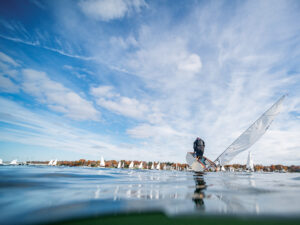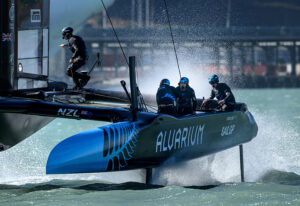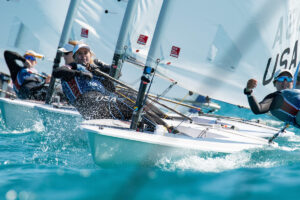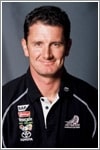
Barry McKay has a sailing resume that would make all but a few sailors drool with envy. He’s now participating in his fourth America’s Cup campaign, all for New Zealand, has won both the Whitbread and the Trophée Jules Verne with Sir Peter Blake, and was the project manager for Hasso Plattner’s maxi Morning Glory when it broke the Sydney-Hobart Record in 1996. He also managed Chris Dickson’s shore program during the 1993-94 Whitbread. Yet when asked whether he expects to find himself onboard Team New Zealand’s race boat for the first race of the 2003 America’s Cup, the 35-year-old native of Dunedin says, without a trace of sarcasm, “Oh, we’ll wait and see. Who knows.” The fact is that it would shock nearly everyone if McKay (pronounced ma-KYE) wasn’t running the pit in Race 1, and for the majority, if not all, of the 2003 Cup races for that matter. But, as he explains, when asked why the team hasn’t revealed its starting squad, “we have a squad of guys who have all done a lot of work. The guys that don’t sail in the Cup are just as important as the guys that do because they pushed the team to a level where they’re capable of winning the Cup. So we’re sensitive to the squad.” As important as his role on the boat will be come race day, McKay earned his keep many times over before the team even hit the water. He was one of the first sailors from the 2000 defense crew to announce his intentions to stay with Team New Zealand–stemming the flow to foreign syndicates–and when the team was looking to secure crucial funding, it was McKay’s connection with Plattner which paved the way for Plattner’s company SAP signing a major sponsorship deal with the defense.
You were one of the first guys to sign on for this defense. How different is this campaign from the last one?
Its a lot different really. From Day 1, when we signed up, it was really nothing, apart from a couple of boats, part of the design team, and Dean Barker. There wasnt too much else; we had a lot of rebuilding to do. So we really have had to fight tooth and nail just to be here, not only in terms of securing the right personnel and training them, but also from the point of view of raising the budget so that we can be competitive. I guess a lot more of us have been involved in helping with those decisions and making those things work so we can be here on the day and do the job.
You were involved in helping sign SAP as a sponsor. It seems like its much more of a cooperative effort than before?
Absolutely. Weve had to have a hand in a lot of things to make it work. The sailing team has played a big part in the fundraising this time. The SAP deal represents close to 20 percent of our budget and at that time it was important for us when they came on because things started to snowball after that and other sponsors had more confidence.
One of the things this team will lack will be actual race experience. Being one of the guys with experience how have you tried to prepare the younger guys for this unique experience?
We talk about that a bit. We do what we can to work on keeping our game calm and focused. Its always going to be a very difficult thing to prepare for because everybodys different and the tow out through the Viaduct on Race 1 is pretty overwhelming, no matter how staunch you are. Its a hard thing to prepare for. At the end of the day its just another race. Theyve done hundreds, if not thousands, of them up to this point. Theres no reason to treat it any differently.
|
|
| |
|
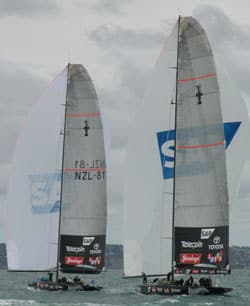
|
| |
| Stuart Streuli|
| |
|
|
| |
| In-house racing, says McKay, has helped to prepare a somewhat inexperienced team for the pressure of the America’s Cup.* * *|
| |
|
|
|
All you have is in-house racing. How would you rate the intensity of your in-house racing? Has it prepared you for the Americas Cup?
We have to be incredibly disciplined about creating that intensity. That can be very difficult to do. But if everybody takes it on and creates the intensity, it becomes pretty powerful. We cant recreate the crowds and we cant paint the boat another color and put Russell Coutts on it. But we can still do a pretty good job of recreating intensity. That comes from each guy, each individual, and that seems to be working.
People often credit much of Russells success to the cooperation he gets from his core crew. Have you developed that sort of synthesis among your key guys?
I sailed with Russell in the last Cup and Ive sailed with him on and off through the years–they wanted me to go to Switzerland. When I compare the mechanics of the crew we have now, the young guys, their strength and fitness and their ability to learn, its ahead of where weve ever been before. In terms of the crew gelling around Dean and Hamish, its not a problem.
How impressed have you been with Dean Barker? A relatively young sailor, whos assumed a huge role in this team.
Well, hes not so young, but hes clearly had to fill some pretty big shoes. Hes stepped in there and done his best in whats been a far from ideal situation. Hes done his best, same as everybody in the team, and so far so good. Hes going just fine.
Last time you were in the pit, should we see you on the boat again, is that where well see you again?
Probably. We have another position call the runner pit where you work the runners upwind and then you go forward and do the pit at the corners.
Any regrets about not going to Alinghi?
No. As long as the Americas Cups in New Zealand, theres no reason to sail for anyone else.
Should you guys successfully defend the Cup will you be more proud of this effort?
Oh yeah. Like I said before, this team has really had to fight tooth and nail just to survive. Weve come a long way and were pretty proud of what weve achieved. Clearly itll be a much more important and bigger victory for us when we pull it off.

